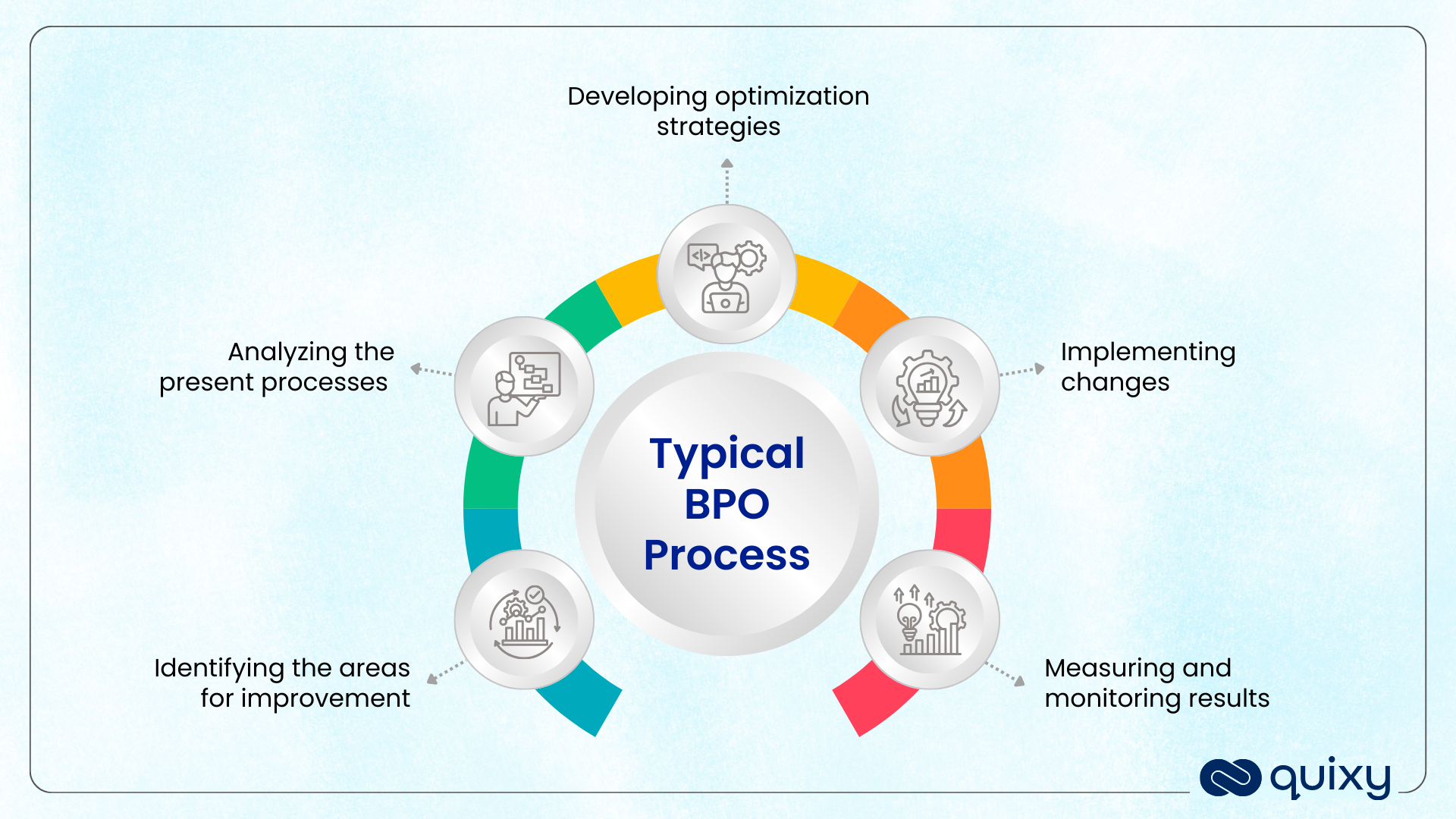October 16, 2025
 by Daniel Corin Stig / October 16, 2025
by Daniel Corin Stig / October 16, 2025

Every business leader wants to boost productivity and lower costs. Automation tools can help, but they don’t solve the challenge of managing multiple complex processes at once.
Business Process Outsourcing (BPO) offers a smarter path, empowering companies to delegate routine work, reduce inefficiencies, and focus on what truly drives success.
Business process outsourcing refers to contracting specific business functions to external providers, allowing companies to focus on their core competencies while experts handle non-essential operations. This strategy enhances efficiency, reduces costs, and increases flexibility across departments.
To maximize the impact of outsourcing, organizations often integrate Business Process Management (BPM) software, which provide visibility into workflows, tracks performance, and ensures optimized collaboration between in-house and outsourced teams.
is the projected revenue for the Business Process Outsourcing (BPO) market in 2030.
Source: Statista
There are two primary categories of BPO:
The outsourcing industry has evolved rapidly since the 1970s, when large manufacturers first began offloading non-core processes to reduce costs. Today, thanks to technology and globalization, BPO is accessible to businesses of all sizes, from startups to global enterprises, seeking to operate smarter and scale more efficiently.
Businesses turn to BPO to stay competitive, gain access to global expertise, and focus on the work that drives growth. With these benefits in mind, let’s explore the main reasons companies turn to outsourcing as part of their growth strategy:
BPO originated as a way to cut costs by transferring non-essential processes to external providers. Globalization has expanded this advantage, providing companies with access to skilled talent in emerging economies where labor and operating costs are lower. Vendors in these regions often offer competitive pricing due to cost efficiencies, favorable tax conditions, and high market competition, helping businesses maximize savings without compromising quality.
Outsourcing also enables global reach. For front-office functions such as customer service or sales, offshore call centers and regional partners make it easier to serve customers across different time zones and languages. Beyond operational support, strategic outsourcing partnerships can help companies tap into innovation hubs, such as Silicon Valley, accessing advanced technology, specialized expertise, and regional insights that fuel market expansion.
Outsourcing provides the agility that many organizations struggle to achieve internally. While in-house teams can be slowed by bureaucracy or resource limitations, BPO vendors can quickly scale operations up or down as business needs change. This flexibility allows companies to adapt to new market conditions, seasonal demands, or strategic pivots without long-term hiring or infrastructure commitments.
BPO providers often specialize in specific processes, meaning they’ve already refined their workflows, invested in advanced tools, and trained expert teams. By outsourcing, companies gain access to specialized efficiency, achieving faster turnaround times, better accuracy, and higher output compared to managing the same tasks in-house.
Core focus can look different across industries; for instance, some digital agencies keep web design in-house but outsource only web development, while others do the opposite, depending on their strategic strengths. By delegating routine or administrative work to third-party experts, organizations can redirect internal talent and resources toward innovation, customer experience, and long-term growth.
Understanding how BPO works is essential for companies looking to enhance their performance and reduce costs

Source: quixy
Organizations use a variety of approaches to refine and enhance their operations. Some widely adopted methods include:
BPO is often categorized according to the vendor's proximity to the buying company, which affects the types of benefits and relationships that are available.
Offshore BPO vendors are located in countries far away from where the buying company is located. This would normally indicate that the outsourcing vendor can offer something that is not available domestically or in any of the neighboring countries, such as lower labor costs.
In the early days of outsourcing, this option was only available to large companies that could afford to travel and learn to do business in cultures and regulatory environments that were different from their own. Today, it’s not only a luxury of large companies, thanks to advancements in technology and the fact that most markets are welcoming foreign business.
Example: A U.S.-based company outsourcing its human resource operations to a vendor in the Philippines. The Philippines has a strong English-speaking workforce and cultural affinity with the U.S., making it an appealing choice.
Outsourcing processes to vendors in neighboring countries is referred to as “nearshoring”. Nearshore vendors can be assumed to be more similar to local vendors in terms of culture, labor costs, and tax regulations than offshore vendors.
Example: A Canadian company outsourcing its IT support to a vendor in Mexico. The proximity allows for effective communication and collaboration, and the cultural similarities help ensure a smoother working relationship.
The final category of vendors is onshore vendors that are located in the same country as the buying company. Labor costs and regulations are likely to be similar, except for differences between states. Hence, the main benefits of outsourcing to an onshore vendor are specialization, both internally and for the vendor, and flexibility.
Example: A retail company outsourcing its marketing services to an onshore agency in New York. By doing so, the company can tap into specialized marketing expertise and creative talent while maintaining close collaboration with the vendor.
Most companies today work with business process management in one way or another. Here are a few business process outsourcing examples to illustrate its reach across different sectors.
Coca-Cola is an interesting example of how outsourcing can help both with global presence and focus. Production is not the key to their success, so they’ve outsourced that process via franchising to companies closer to each market. The syrup and its recipe are kept internally, but the bottling and distribution are performed by other companies.
iPhone owners can see proof of another outsourcing example right in their pockets. The text on the back of the iPhone reads, “Designed by Apple in California. Assembled in China”, and there are several reasons why Apple has production in China and not in the US. One important reason is to be able to cope with the volume of products, which requires both an ecosystem of suppliers in the area and access to a skilled workforce.
An outsider in this list is Tesla, as they have decided not to outsource dealerships and charging stations, as most other auto manufacturers do. Instead, they are betting on vertical integration of these businesses to keep closer control over them. Surveys have shown that customers are very satisfied with the services provided by Tesla, but it has been an expensive investment, and it remains to be seen how it pays off in the long run.
Not all outsourcing partnerships are created equal. Before selecting a BPO provider, it’s crucial to assess the type of relationship your organization needs, based on the level of collaboration, control, and strategic importance of the process being outsourced.
Strategic BPO partnerships involve close collaboration around high-value or complex business functions, such as R&D, product development, or data analytics. These relationships often require joint planning, shared technology, and continuous communication to align goals.
Companies choose this model when outsourcing functions that directly influence customer experience, innovation, or competitive advantage. For example, a software company might partner with a specialized analytics provider to co-develop AI-driven insights for its customers.
Best for: Long-term innovation, complex projects, and shared business outcomes.
In contrast, hands-off BPO models are designed for standardized, repeatable tasks where expertise and efficiency matter more than strategic collaboration. Here, the vendor operates independently under clearly defined performance metrics and SLAs.
This model enables companies to minimize costs and management overhead while maintaining consistent quality. For instance, an e-commerce brand might outsource its payroll processing or customer support to a third-party vendor with minimal day-to-day involvement.
Best for: Routine, transactional processes that benefit from scale and cost efficiency.
The right model depends on your business goals:
Understanding where your outsourcing needs fall on this spectrum ensures a smoother partnership, clearer expectations, and better overall results.
By transferring specific business functions to external vendors, companies can leverage a range of advantages that contribute to their overall success. Below are some key benefits of business process outsourcing:
On the flip side, there are several disadvantages associated with business process outsourcing. While it offers numerous benefits, organizations must also navigate various challenges. Some of these challenges include:
According to G2’s Grid Report for Quality Management Software, we’ve analyzed real user feedback and data to highlight 9 of the best quality management tools.
Before rounding off the topic, we wanted to leave you with a quick teaser to inspire you to learn more about BPO. After learning what it is and how it works, you’re probably eager to learn how to successfully do it.
In their book ”Nine Keys to World-Class Business Process Outsourcing,” Mary Lacity and Leslie Willcocks draw on over 2,500 interviews with executives across the globe to define ways to improve the chance of success in an outsourcing setup.
Here’s a quick summary of the book:
As seen from this list, many skills and processes are required to master BPO. If it’s core to your business, knowing how to outsource processes exceptionally well could become a competitive advantage in itself. If not, perhaps you can outsource the process of outsourcing as well.
Finally, let’s see what Leslie Willcocks, one of the authors of the book about World-class BPO, just mentioned, has to say about the future of outsourcing. Two things he projects are that there are going to be “digital businesses” supported by outsourcing and that knowledge work will also become automated by outsourcing providers that can manage unstructured data:
Business process outsourcing has empowered organizations across various industries to focus on they core competencies, while experts handle the rest. By reallocating time, talent, and capital toward core operations, companies can reduce costs, improve agility, and scale with confidence.
Success in BPO, however, depends on choosing the right partnership model. A hands-off vendor may work well for standardized, transactional tasks, but complex, strategic initiatives demand collaboration, trust, and continuous communication. The best relationships are built on shared goals and transparent performance management.
Enhance your organizational efficiency by automating complete processes using digital process automation (DPA) software.
This article was originally published in 2020. It has been updated with new information.
Daniel Corin Stig is a board member and former CEO of White Label Agency, a WordPress outsourcing company that helps digital agencies get more development capacity for their web projects. Daniel has a PhD in Technology Management from Chalmers University of Technology in Sweden.
The purpose of starting a business is to solve a problem.
 by Diksha Singh
by Diksha Singh
Expensive outbound marketing isn’t the only way to approach prospective clients.
 by Caroline Lee
by Caroline Lee
If you’re running a small business, chances are you grapple with low productivity from time to...
 by Taru Bhargava
by Taru Bhargava
The purpose of starting a business is to solve a problem.
 by Diksha Singh
by Diksha Singh
Expensive outbound marketing isn’t the only way to approach prospective clients.
 by Caroline Lee
by Caroline Lee


